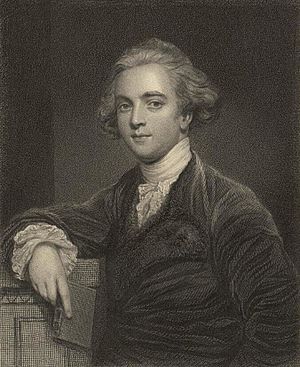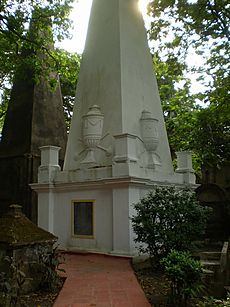William Jones (philologist) facts for kids
Quick facts for kids
William Jones
FRS FRAS FRSE
|
|
|---|---|

A steel engraving of Sir William Jones, after a painting by Sir Joshua Reynolds
|
|
| Puisne judge of the Supreme Court of Judicature at Fort William in Bengal | |
| In office 22 October 1783 – 27 April 1794 |
|
| Personal details | |
| Born | 28 September 1746 Westminster, London |
| Died | 27 April 1794 (aged 47) Calcutta |
Sir William Jones (born September 28, 1746 – died April 27, 1794) was an amazing scholar from Britain. He was a philologist, which means he studied languages and how they developed. He also worked as a judge in India and was very interested in ancient Indian culture.
Jones is famous for suggesting that many European and Indian languages came from a common ancestor. He called this group of languages "Indo-European." He also helped start the Asiatic Society of Bengal in 1784, which was important for studying Asia.
Contents
About William Jones
William Jones was born in London. His father, William Jones, was a mathematician who introduced the symbol for π. Sadly, William's father died when he was only three years old, and his mother, Mary Nix Jones, raised him.
From a young age, William was a language genius. Besides English and Welsh, he learned Greek, Latin, Persian, Arabic, Hebrew, and even some Chinese writing. By the end of his life, he knew eight languages very well, could speak eight more with a dictionary, and understood twelve others fairly well!
He went to Harrow School and then University College, Oxford. After graduating, he became a tutor to Lord Althorp, the son of Earl Spencer. For six years, he worked as a tutor and translator. During this time, he translated a Persian book into French. This was for King Christian VII of Denmark, who visited Jones because he was already known as an expert on Eastern cultures.
Life in India
In 1770, Jones began studying law. This was in preparation for his work in India. He became a member of the Royal Society in 1772. After working as a judge in Wales, he was appointed a judge for the Supreme Court of Judicature at Fort William in Calcutta, Bengal, on March 4, 1783. He was also made a knight, becoming "Sir William Jones."

In April 1783, he married Anna Maria Shipley. She was an artist and helped him record what life was like in India. They arrived in Calcutta on September 25, 1783.
Jones was very interested in Indian culture, which was not well-known in Europe at the time. On January 15, 1784, he started the Asiatic Society in Calcutta. He studied the Vedas, which are ancient Hindu texts, and became very good at Sanskrit, an ancient Indian language. He also learned about Hindu laws.
Over the next ten years, he wrote many books about India. He helped start the modern study of India in many areas, including laws, music, literature, plants, and geography. He also translated important Indian books into English.
Sir William Jones sometimes used the pen name Youns Uksfardi, which means "Jones of Oxford." He died in Calcutta on April 27, 1794, at the age of 47. He is buried in the South Park Street Cemetery.
Amazing Language Discoveries
Jones is best known for noticing how different languages are related. In 1786, he suggested that Sanskrit (an ancient Indian language), Greek, and Latin languages all came from a common source. He also thought that Gothic (an old Germanic language) and Celtic languages (like Irish or Welsh) might be related to them, as well as Persian.
Even though Jones is famous for this idea, he wasn't the very first to notice these similarities. Other scholars before him had also seen connections between Indian and European languages. However, Jones's work was very important because it helped start the study of comparative linguistics, which is about how languages change over time and how they are related.
He famously said:
The Sanscrit language, whatever be its antiquity, is of a wonderful structure; more perfect than the Greek, more copious than the Latin, and more exquisitely refined than either, yet bearing to both of them a stronger affinity, both in the roots of verbs and the forms of grammar, than could possibly have been produced by accident; so strong indeed, that no philologer could examine them all three, without believing them to have sprung from some common source, which, perhaps, no longer exists; there is a similar reason, though not quite so forcible, for supposing that both the Gothic and the Celtic, though blended with a very different idiom, had the same origin with the Sanscrit; and the old Persian might be added to the same family.
This "common source" he talked about is now called Proto-Indo-European.
Jones also had some ideas that seem strange today. For example, he thought that ancient Egyptian priests might have moved to India a long time ago. He also believed that the Chinese people were originally Hindus from the Kshatriya caste (a social group in India). These ideas are not supported by evidence today.
He also wrote about poetry, saying that the best parts of poetry, music, and painting show strong feelings and emotions. This idea was important for the Romantic movement in literature.
Chess Poem
When he was 17, in 1763, Jones wrote a poem called Caissa. It was based on an older poem and tells a mythical story about how the game of chess began. This story became very well known in the chess world.
In the poem, a nymph named Caissa doesn't like Mars, the god of war. Mars then asks the god of sport for help. The god of sport creates the game of chess as a gift for Mars to win Caissa's heart. Mars plays the game and wins her over.
Because of this poem, Caissa is now often called the "goddess" of chess. Her name is used in many ways in modern chess.
Memorial
There is a memorial to Sir William Jones in the crypt of St Paul's Cathedral in London.
See also
 In Spanish: William Jones (filólogo) para niños
In Spanish: William Jones (filólogo) para niños

